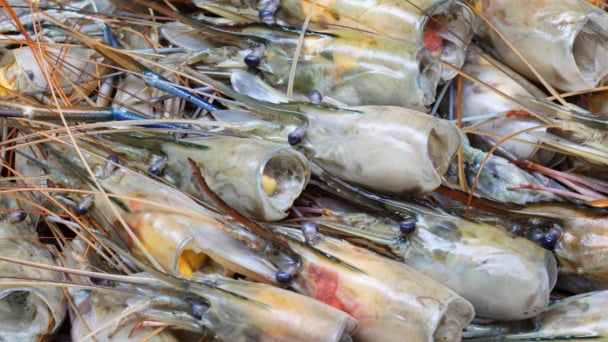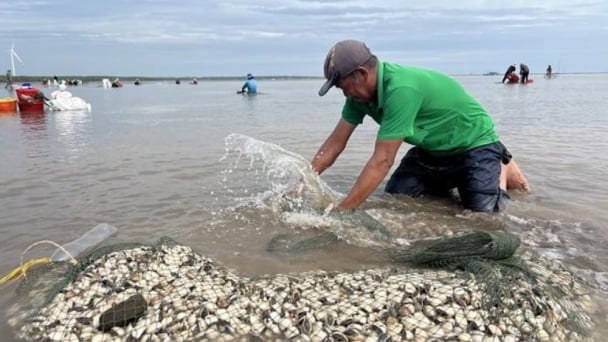May 30, 2025 | 23:29 GMT +7
May 30, 2025 | 23:29 GMT +7
Hotline: 0913.378.918
May 30, 2025 | 23:29 GMT +7
Hotline: 0913.378.918
According to the Plant Protection Department, Sri Lanka Cassava Mosaic Virus (SLCMV) is transmitted by the silverleaf whitefly (Bemisia tabaci) as a vector so it can quickly spread, causing serious damage to cassava growing areas in Vietnam.

In 2021, SLCMV continued to cause serious damage in many key cassava areas. Photo: Dang Lam.
Since its first appearance that caused damage in Tay Ninh Province in June 2017, SLCMV has appeared in 26 provinces and cities across the country. In the past, the plant protection industry has actively taken measures to prevent the disease to minimize its damage.
The Department of Plant Protection issued the Technical Process to prevent SLCMV to localities to instruct the farmers to apply in 2017.
In 2019, the Department of Crop Production also issued the cassava cultivation process and the production process of cassava varieties free of SLCMV so that localities could guide farmers to implement, coordinate assessment of disease-resistant cassava varieties and support the Institute of Agricultural Genetics to announce cassava varieties resistant to leaf mosaic disease.
The National Center for Agricultural Extension has implemented a number of projects to produce disease-free seed and prevent cassava mosaic disease in Tay Ninh.
Research institutes like Vietnam Institute of Agricultural Sciences, the Institute of Genetics, the Institute of Plant Protection have actively participated in researches on measures to prevent and control SLCMV through programs and projects in recent years, notably the project entitled “Development of sustainable cassava production system through pest and disease management in Vietnam, Cambodia, Thailand.”

Up to now, a number of cassava varieties resistant to SLCMV have been identified, but the rapid propagation of these varieties for production is still very limited. Photo: Tran Trung.
The Agricultural Genetics Institute coordinated with the International Center for Tropical Agriculture (CIAT), Japan International Cooperation Agency (JICA) and Food and Agriculture Organization (FAO) to conduct group assessment of domestic and imported cassava varieties under the pressure of natural diseases from October 2018 in Tan Bien and Tan Chau Districts of Tay Ninh Province.
As a result, six varieties of cassava resistant to mosaic leaf disease announced for circulation including: HN1, HN3, HN5, HN36, HN80, HN97 and new varieties are still being selected and created.
Up to now, various provinces (Tay Ninh, Binh Duong, Phu Yen, Kon Tum, Quang Ngai, Ninh Thuan, Thua Thien Hue...) have established the Provincial and District Steering Committees for Disease Prevention and Control to focus and mobilize all resources for the prevention of SLCMV. At the same time, many large cassava-growing localities such as Tay Ninh, Dong Nai, Quang Ngai, Gia Lai, Phu Yen... have also issued many mechanisms and policies to support disease-free cassava varieties and those that are resistant to SLCMV.
In a written report to the Ministry of Agriculture and Rural Development, the Plant Protection Department recommends the Ministry of Agriculture and Rural Development continue to direct the Plant Protection Department, the Department of Crop Production, the National Center for Agricultural Extension and localities to prevent cassava leaf mosaic disease and the Institute of Agricultural Genetics to continue to select and create disease-resistant cassava varieties to meet production needs. Specifically:
The Department of Plant Protection continues to guide localities in the prevention of cassava leaf mosaic disease, in which focus on coordinating with the Institute of Agricultural Genetics, the Vietnam Cassava Association, and the National Center for Agricultural Extension to develop disease-free and disease-resistant breeding plans and transfer them to localities.

Research on testing cassava varieties resistant to mosaic disease HN3, HN5 was conducted in the southeast region in 2021. Photo: TL.
The Department of Crop Production directs localities to organize the production of disease-free varieties according to the promulgated disease-free seed production processes.
The Institute of Agricultural Genetics shall coordinate with the Plant Protection Department to develop a disease-free breeding plan and submit it to the Ministry of Agriculture and Rural Development for approval; continue to coordinate with domestic and foreign organizations to select and breed resistant varieties to SLCMV and other pests and diseases; transfer disease resistant varieties and propagation process to localities and cassava enterprises.
The localities drastically implement measures to prevent SLCMV; direct and strictly control the trading and transportation of diseased cuttings, punish establishments selling seeds of unknown origin or infected varieties; organize a form of sharing disease-free seeds in the community...
The Vietnam Cassava Association in collaboration with the Plant Protection Department and the Institute of Agricultural Genetics organizes disease-free and disease-resistant varieties; call on member enterprises to support farmers with disease-free seeds; directly organize or support organizations and individuals to produce disease-free and disease-resistant varieties.
Currently, the total area for cassava cultivation in Vietnam is 513,200 ha (in which 95,300 ha in the Northern provinces; 53,500 ha in the North Central region; 270,700 ha in the South Central Coast and Central Highlands; and 93,700 ha in the South). Cassava is mainly grown in winter-spring and summer-autumn crops. Commonly grown varieties are KM94, KM 419, KM 140, KM 505, HLS-11 and local varieties.
Translated by Phuong Ha

(VAN) Seafood by-products are opening a new path, combining green growth and technological innovation to enhance the industry's value.

(VAN) Mr. Nguyen Thanh Cong, Vice Chairman of the Son La Provincial People's Committee, reflects on Son La’s journey from barren hills to fruitful orchards after a decade of hard work.

(VAN) FAO’s Director-General addresses the 5th Baghdad International Water Conference.
/2025/05/26/1716-4-nongnghiep-191706.jpg)
(VAN) Chain linkages, technological innovation, and raw material zoning are three strategic pillars for the coconut industry to strongly develop and elevate its position on the global agricultural map.
![Advanced mariculture – an inevitable trend: [4] Accompanied by scientists](https://t.ex-cdn.com/nongnghiepmoitruong.vn/608w/files/sohk/2025/05/13/1941-pgsts-vo-van-nha-140958_717.jpg)
(VAN) According to Assoc. Prof. Dr. Vo Van Nha, Director of the RIA III, the development of advanced offshore mariculture is no longer an option but an essential path for Vietnam’s fisheries sector.

(VAN) Vietnam is intensifying the development of mollusk farming areas that meet international standards, aiming for sustainable growth and enhancing its export position in the global seafood market.
![Advanced mariculture – an inevitable trend: [3] Policy-driven momentum](https://t.ex-cdn.com/nongnghiepmoitruong.vn/608w/files/doanhtq/2025/05/21/0104-0616-0348-nuoi-bien-170339_789.jpg)
(VAN) To ensure the success of offshore mariculture that uses advanced technologies, it is essential to establish supportive policies that inspire both individuals and enterprises to invest with confidence.